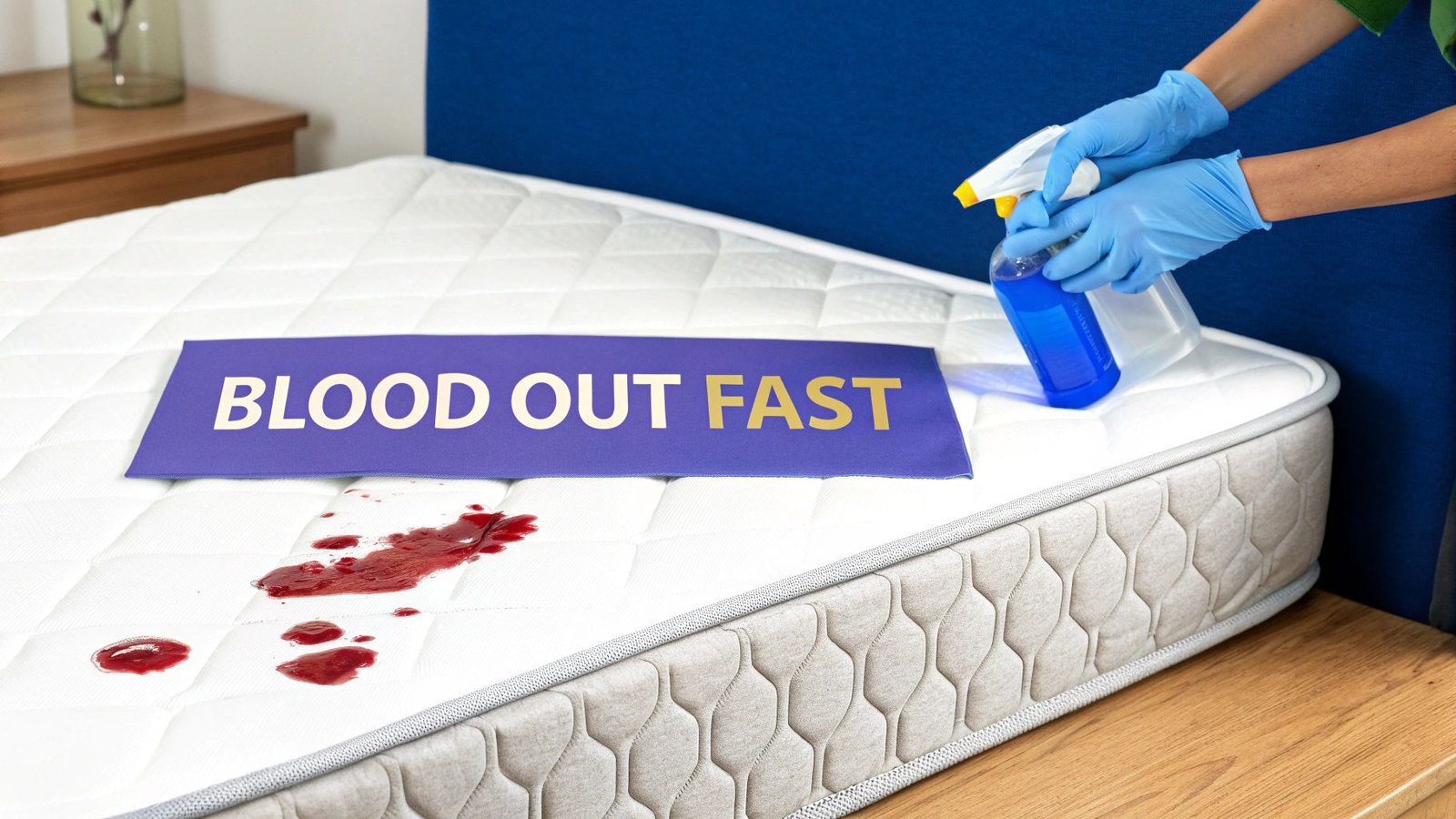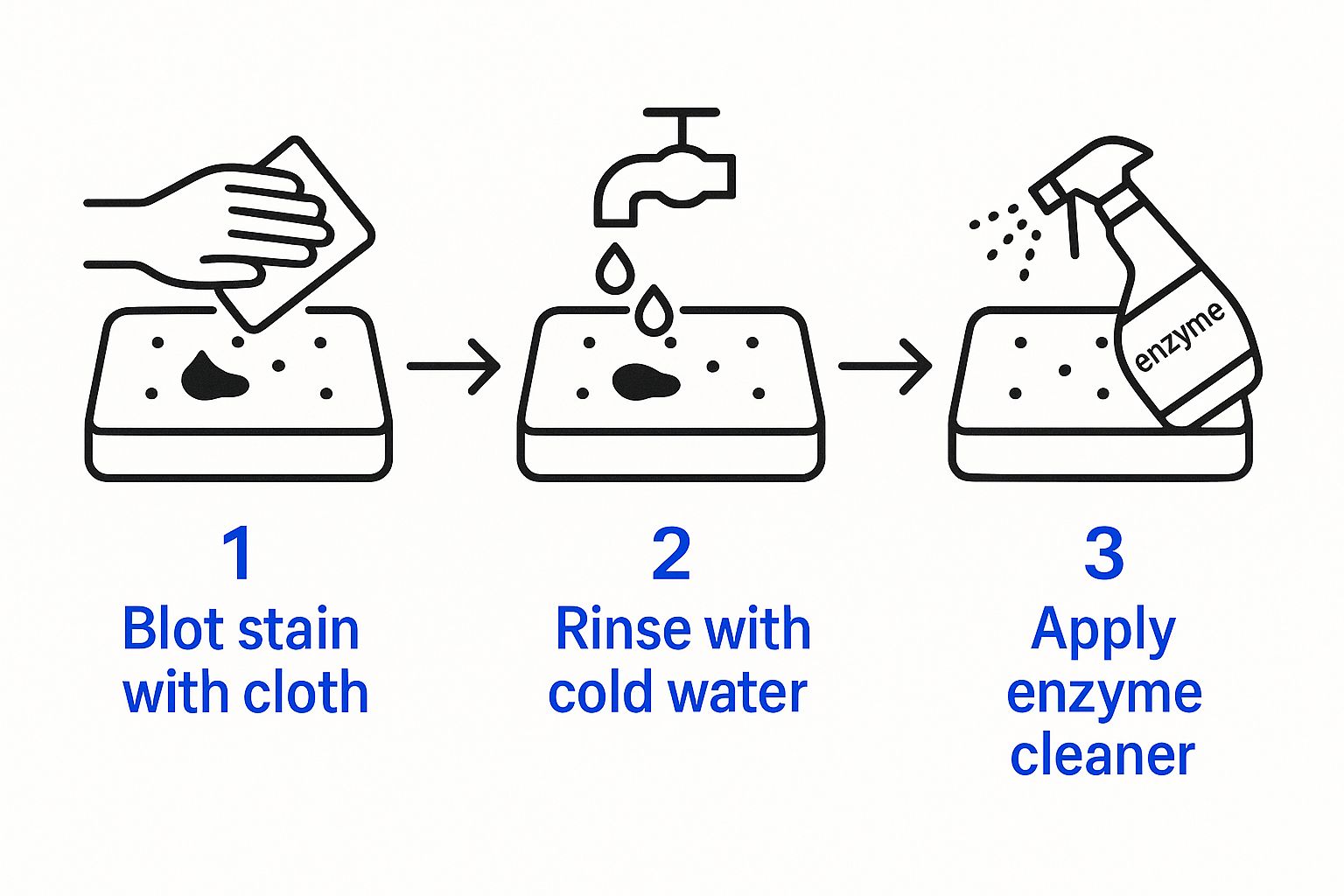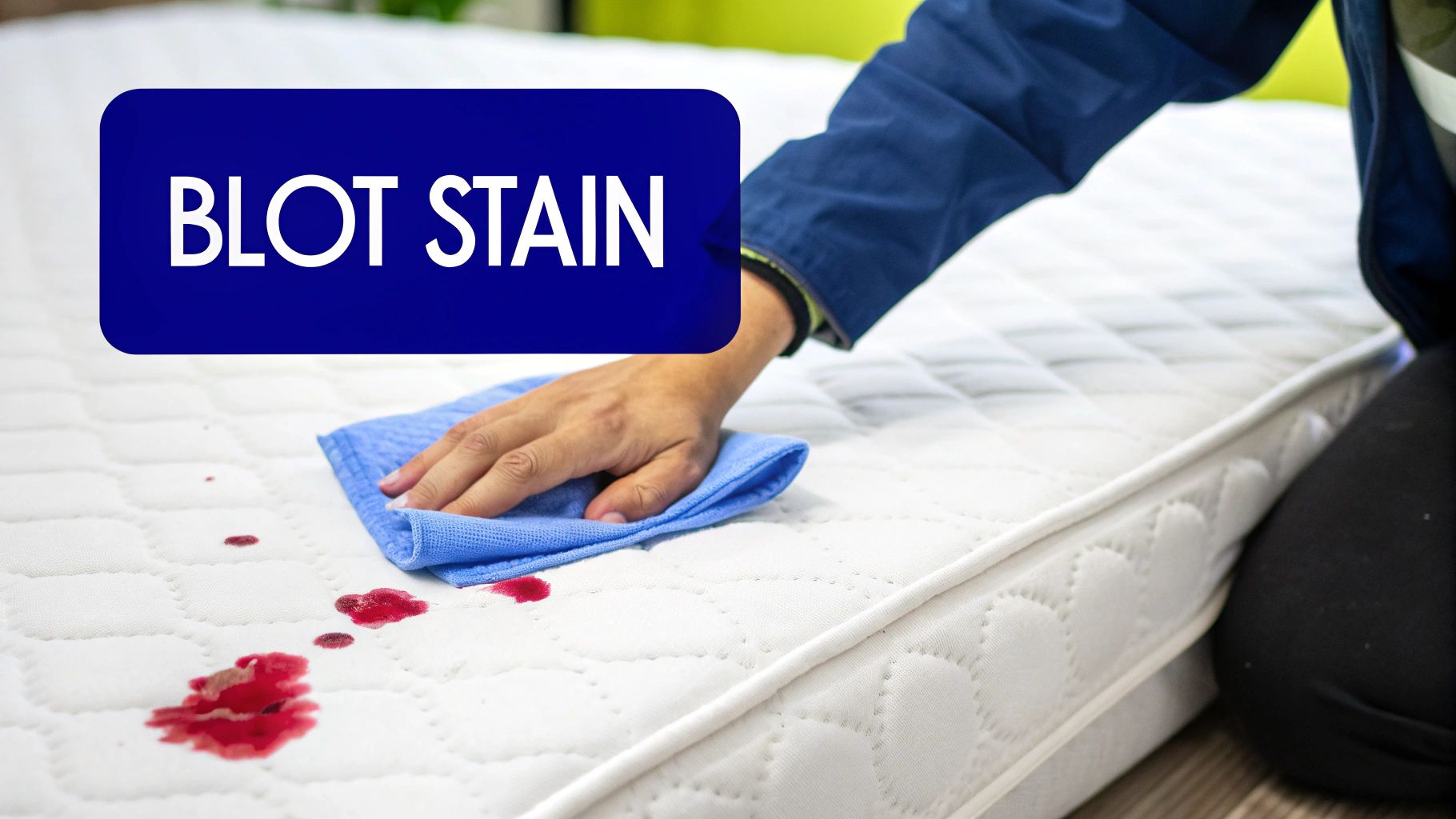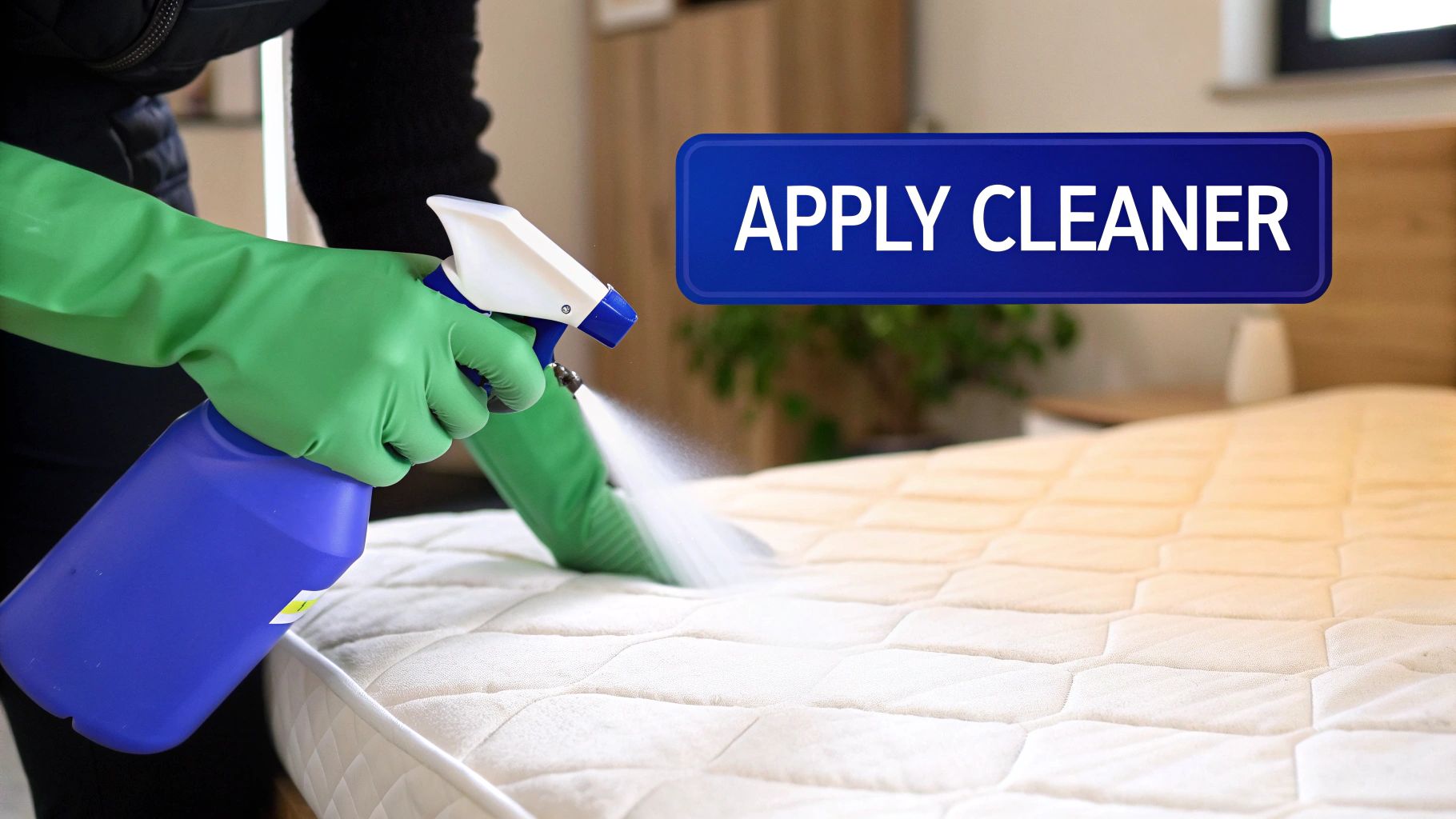How to get blood out of a mattress quickly & effectively

How to Get Blood Out of a Mattress. Finding a blood stain on your mattress is always a bit of a shock, but don’t panic. The absolute key is to act quickly. To get blood out of a mattress without it becoming a permanent mark, you need to blot the fresh stain right away with a clean cloth and only use cold water.
I can’t stress this enough: never use hot water. It will cook the proteins in the blood and set the stain for good.
Your first move when you find a blood stain
Over the past 15 years, I have made it my priority to deliver an exceptional mattress stain removal service for the city of Melbourne and its many suburbs. My training and expertise in this field are second to none. Trust me when I say that what you do in the first few minutes makes all the difference. A quick response is the single most important thing you can do to stop a small accident from turning into a permanent eyesore on your mattress. This isn’t just a cleaning tip; it’s the golden rule of stain removal.
Your immediate goal is to get as much of the blood out as you can before it has a chance to sink deep into the mattress fibres. The science here is simple: blood contains proteins that clump together (coagulate) when they get hot. Using hot water will essentially cook the stain right into the fabric, making it almost impossible to shift later.
Act fast with what you have
You don’t need a van full of professional equipment for the initial response. A couple of simple household items are your best allies here.
- A clean, dry cloth: Use this to gently blot the stain. The idea is to press down, let the cloth absorb the liquid, and lift. Whatever you do, don’t rub or scrub. That just pushes the blood deeper and makes the stain bigger.
- Cold water: Once you’ve blotted up as much as you can, dampen a fresh, clean cloth with cold water and continue dabbing the stain. This helps to dilute what’s left, making it easier to lift out.
This basic process—blot, rinse with cold water, and treat—is your most effective first line of defence.
For those moments when you need a quick reminder, here’s a simple plan to follow within the first 30 minutes of finding a fresh blood stain. Think of it as first aid for your mattress.
Immediate Action Plan for Fresh Blood Stains – How to get blood out of a mattress
| Action | Why It’s Important | What to Use |
|---|---|---|
| Blot, Don’t Rub | Prevents the stain from spreading and setting deeper into the mattress fibres. | A clean, dry, white cloth or paper towel. |
| Apply Cold Water | Cold water helps dilute the blood without setting the protein-based stain. | A clean cloth dampened with cold water only. |
| Absorb Excess Moisture | Removes the diluted blood and cleaning solution, preventing water damage or mould. | A fresh, dry cloth or paper towels. |
Following these steps immediately gives you the best possible chance of removing the stain completely, or at least making the job much easier for a professional later on.

This infographic breaks down the essential first aid for your mattress, focusing on those simple, immediate actions. Cleaning experts across Australia agree that this initial, quick reaction is vital. The process is straightforward: get the bedding off, rinse it separately under a cold tap, and carefully dab—never rub—the stain on the mattress to stop it from spreading. If you’d like more professional advice for mattress care in Australia, there are plenty of resources available.
Effective DIY Stain Removal Solutions

Once you’ve blotted the initial spot with cold water, it’s time to get a bit more targeted. With over 15 years of dedicated service to all of Melbourne’s suburbs, I’ve seen which DIY solutions really work and which ones just make a bigger mess.
You don’t always need professional chemicals for a fresh stain. Believe it or not, some of the most reliable ingredients are likely already sitting in your kitchen pantry. These are the methods I recommend to my clients for immediate, effective action when they call in a panic.
Create a powerful cleaning paste
For slightly dried or more stubborn fresh stains, a simple paste can work wonders. The idea is to make a thick mix that you can lay right on the stain. This allows the ingredients to do their job and draw the blood out of the mattress fibres.
You can whip up a great paste using a few common household items:
- Baking Soda & Water: This is a classic for a reason. Mix three parts bicarb soda to one part cold water. You’ll get a thick, absorbent paste that’s fantastic for lifting stains and neutralising odours.
- Salt & Cold Water: A simple mix of salt and a few drops of cold water creates a paste that acts as a gentle abrasive. It helps to break down the blood proteins without being too harsh on the fabric.
- Cornstarch, Salt & Hydrogen Peroxide: For a bit more cleaning muscle, combine a ½ cup of cornstarch with a ¼ cup of hydrogen peroxide and a tablespoon of salt. This is my go-to recommendation for tougher spots that need a little extra help.
Apply your chosen paste generously over the entire stain. You want to cover it completely. Then, let it sit for at least 30 minutes or until it’s bone dry. Once it’s dried, scrape off the excess with a spoon and give the area a thorough vacuum.
My Personal Tip: The key to success with any of these pastes is patience. I know it’s tempting, but don’t scrub it off while it’s still wet. Letting the paste dry completely is what gives it the power to absorb and lift the stain from deep within the fibres.
Using hydrogen peroxide safely
For those tougher, more persistent stains, 3% hydrogen peroxide can be an incredibly effective tool. However, and I can’t stress this enough, you must use it with caution as it has mild bleaching properties. I’ve seen this method save many mattresses, but I’ve also seen it cause permanent discolouration when used incorrectly.
Always perform a patch test first. Find a hidden spot on your mattress, like a seam on the underside, and apply a tiny amount. Wait a few minutes to make sure it doesn’t lighten or damage the fabric.
If the test goes well, apply a small amount directly to the stain. You’ll see it start to bubble and fizz – that’s the oxidative reaction breaking down the blood. Gently blot the area with a clean, dry cloth to lift the residue. Don’t pour it on, and never saturate the mattress with it.
For a more comprehensive look at various stain removal methods, you can check out our guide on how to get stains out of a mattress.
Common mistakes that can ruin your mattress

Sometimes, knowing how to get blood out of a mattress is more about what you don’t do. After 15 years of fixing cleaning disasters across Melbourne, I’ve seen countless well-intentioned efforts cause permanent damage. Believe me, some mistakes are far worse than the original stain.
One of the biggest blunders I see homeowners make is grabbing the wrong cleaning agent. Certain chemicals might look like a powerful, quick fix, but they can cause irreversible harm to your mattress fabric.
Avoid harsh chemicals and aggressive scrubbing
Never, ever use bleach or cleaners that contain ammonia. While they seem like the logical choice for a tough stain, these chemicals are far too aggressive for mattress materials. They’ll literally eat away at the delicate fibres, often leaving a permanent, ugly yellow stain that’s much more noticeable than the initial blood spot.
Another common pitfall is scrubbing too hard. I get it – you panic and want the stain gone, so you start rubbing frantically. But this doesn’t lift the stain. Instead, you’re just grinding the blood deeper into the mattress layers and risking a tear in the fabric. The only way to do it right is to blot gently, working from the outside of the stain inwards.
My dedication over the past 15 years to serving all of Melbourne’s suburbs has shown me that patience is your best tool. Harsh chemicals and vigorous scrubbing are the two fastest ways to turn a solvable problem into a ruined mattress.
The danger of over-wetting your mattress
It’s easy to think that more water means a better clean, but with mattresses, this is a critical error. Soaking the stained area with too much water or cleaning solution doesn’t solve the problem; it creates a much bigger one.
When excess moisture gets trapped deep inside the mattress, there’s no airflow to dry it out. This damp, dark environment is the perfect breeding ground for mould and mildew. What started as a simple stain can quickly escalate into a serious health hazard, compromising your entire bed. If this happens, you’ll likely need professional help. You can learn more about what that involves in our guide to dealing with mould on a mattress.
Always use liquids sparingly and make absolutely sure the mattress is bone dry before you even think about putting sheets back on. A little bit of care here will prevent a massive headache down the track.
When to call in a professional cleaner

While I’m a big advocate for good DIY methods on fresh stains, there are definitely times when you need to put down the bicarb soda and pick up the phone. Knowing when a stain is beyond a home remedy isn’t admitting defeat; it’s the smart play to protect your mattress and make sure it’s genuinely clean. As a professional dedicated to serving all of Melbourne’s suburbs for over 15 years, I know exactly when my expertise is a necessity, not a luxury.
The most common reason I get a call is for an old, dried blood stain. Once blood has had time to set, its proteins form a powerful bond with the mattress fibres. This makes them incredibly tough to dissolve with anything you’d find in your cupboard. Store-bought cleaners just don’t have the oomph. We use powerful, professional-grade enzymatic treatments specifically designed to break down these stubborn proteins without harming the mattress fabric itself.
Your mattress type matters
Another crucial factor is the type of mattress you own. A method that works wonders on a standard innerspring mattress could completely ruin a memory foam or latex bed. These materials are famously sensitive to moisture and harsh chemicals. One wrong move and you could be looking at permanent damage or even saying goodbye to your warranty.
- Memory Foam & Latex: These can be wrecked by too much liquid. It degrades the foam’s structure and is a fast track to mould growth. We use special low-moisture techniques to clean deeply without over-saturating the material.
- Innerspring & Hybrids: While these are more forgiving, a deep stain can soak right through the top layers. This requires serious extraction equipment to pull the stain out from the core of the mattress.
- Organic & Natural Fibres: Materials like wool or organic cotton need very specific, pH-neutral cleaning solutions. The wrong product can cause discolouration or damage the delicate fibres.
Knowing how to get blood out of a mattress professionally is really about understanding fabric science. Each material reacts differently, and using a one-size-fits-all approach is why so many DIY attempts on tough stains end in disappointment.
There’s a good reason professional mattress cleaning is a specialised field in Australia. The materials vary so widely, from wool blends to complex synthetic fibres, and each one demands its own cleaning plan. In fact, industry reports show that over 60% of professional call-outs for mattress cleaning are for blood stains, which just goes to show how often people need an expert’s help. You can read more about why experts often advise against DIY for blood stains at AllAces.com.au.
So, if you’re staring down a stubborn stain, or you’re just not sure how to tackle it without causing more harm, calling for help is your safest bet. A professional mattress cleaner has the right tools and the experience to get your bed back to its best, safely and hygienically.
Serving all of Melbourne with expert care
For more than 15 years, I’ve made it my mission to deliver an exceptional mattress cleaning service to every corner of Melbourne and its many suburbs. From the bustling CBD to the quietest outer neighbourhoods, my dedication is to provide unparalleled expertise. This isn’t just a job for me; it’s a craft I’ve honed over thousands of hours of hands-on work.
My experience isn’t just from a textbook. It’s built on a real, practical understanding of what works, especially for tricky jobs like getting blood out of a mattress. I believe every Melbournian deserves a reliable, expert service they can trust to come into their home.
When you call, you’re getting me—a dedicated professional with unmatched training and expertise, who genuinely respects your home and your time. My priority is simple: to deliver an exceptional result that brings your mattress back to its best possible condition with care and precision.
It doesn’t matter if you’re in an inner-city apartment or a house in the suburbs; my commitment is to be there for you. I bring my specialised knowledge and all the right equipment straight to your doorstep, ensuring everyone across Melbourne has access to a truly hygienic, professionally cleaned mattress.
Got questions? I’ve got answers
After 15 years in the mattress cleaning industry, delivering exceptional service to all of Melbourne’s suburbs, I’ve pretty much heard it all. When it comes to tackling something as tricky as a blood stain, it’s natural to have a few questions. Here are some of the most common ones I get asked.
Common Queries from Melbourne Homes
Can I Use Hydrogen Peroxide on Any Mattress?
Hydrogen peroxide can be a handy tool, but you’ve got to be careful. It has mild bleaching properties, which is why I always tell my clients to test it on a small, hidden spot first—like a seam on the underside.
While it’s usually fine for standard spring mattresses, you should use it very sparingly on memory foam. Over time, it can actually cause the foam to break down and degrade.
How Long Does a Mattress Take to Dry After Cleaning?
This really depends on the airflow in the room and the humidity on the day. A small spot clean might only take 2-4 hours if you’ve got a window open or a fan going.
After I’ve done a full professional clean, it typically takes about 6-10 hours. The most important thing is to make sure the mattress is bone dry before you even think about putting sheets back on. Trapping any moisture is a surefire way to invite mould.
Can You Really Get an Old Blood Stain Out?
Honestly, this is where my 15 years of expertise really shines. While your DIY attempts might struggle with an old, set-in stain, a professional has a much, much higher chance of success. I use commercial-grade enzymatic cleaners specifically designed to break down the aged proteins in dried blood—something the products you buy at the supermarket just can’t compete with.
Just like my guide here, you’ll find that many professional service sites offer a dedicated FAQs section to help answer those common queries before you even have to pick up the phone.
If you’re looking at a stubborn stain and would rather leave it to an expert with over a decade of hands-on experience, Mattress Cleaning Melbourne is here to help. My exceptional stain removal service is available to all of Melbourne and its surrounding suburbs. I am dedicated to leaving your mattress hygienically clean. Contact me for a free quote today!